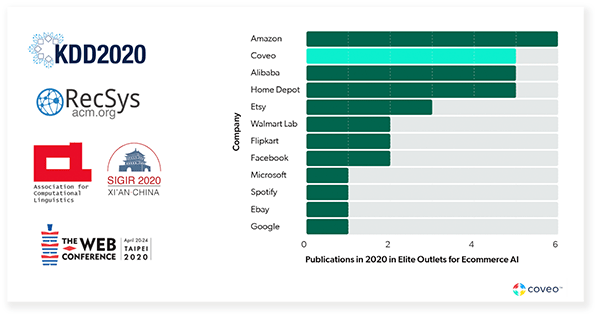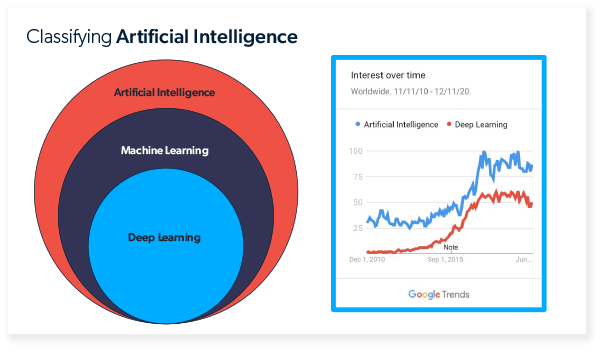When it comes to choosing a site search engine for an ecommerce platform, evaluating an ecommerce search vendor is a cumbersome task.
Multiple vendors tout AI capabilities. As Gartner analyst, Mike Lowndes pointed out , “merely using AI is also no longer differentiating.” Most site search and discovery vendors now “use machine learning or other forms of AI to enhance their products,” he continued.
So how can you choose the right ecommerce search engine for your ecommerce store?
Ask yourself (and your vendor/vendors!) these six questions when evaluating options for your ecommerce store.
Is Your AI Tailored to Ecommerce Site Search?
When choosing an off-the-shelf AI search solution for ecommerce, it’s crucial to know if that solution is designed particularly for digital commerce. While some flexibility in an ecommerce search engine can be desirable, specificity is far more crucial.
Yet, way too often, buyers choose to overlook this.
AI models trained on huge datasets can influence user experience on an ecommerce search platform. But it’s not a question of how much data — again, the emphasis needs to be on fine-tuning models with relevant data. And that relevant data comes from leveraging your ecommerce site expertise.

We’ve seen a lot of interest in Natural Language Processing (NLP) advancements . Customers are now used to a Google-like user experience, namely finding relevant results from search queries that match their natural language. And we, as ecommerce suppliers assume that the best way to meet customers’ search bar expectations is by opting for language models pre-trained on giant datasets.
Ecommerce search engine advancements with NLP have boomed, starting in 2018 with the launch of two massive deep learning models: GPT (Generative Pre-Training) by Open AI, and BERT (Bidirectional Encoder Representations from Transformers) by Google.
There are non-trivial differences between these two. For example, BERT is open-sourced and can be fine-tuned. GPT-3 is not open-sourced and cannot be fine-tuned (even if you had access to the actual weights, fine-tuning it would be very expensive).
What’s more important is how each model has been trained. Both were trained on generic search query data, not ecommerce site search query data specifically. This means that these models may not be precise enough for ecommerce site search .
An ecommerce search engine needs to be specific to the relevant use case. Quirks that make ecommerce site search different are also why some popular NLP approaches may stumble.
For instance, shoppers don’t really search with words (a.k.a., create much linguistic data) when shopping on an ecommerce site. After all, not everyone uses a search box, and those who do – often use a single keyword instead of a sentence. On the other hand, users do click around often, generating a lot of behavioral data. Using this data, you can focus on developing a user behavior strategy that, in the long run, can improve the efficiency of search result and conversion rate. This is the reasoning behind the development of our proprietary technology based on product embeddings.
How Does the AI Platform Handle Small Data?
While it’s easy to assume that almost every business is snowed under with an avalanche of data, this isn’t really the truth. Data is available only to a small set of brand names- in many cases data is considered a scarce resource .
In a real-world online store setting, data is often hard to get and can be of questionable quality.
Most companies aren’t Amazon. For instance, Amazon has tons of historical data on customer purchases – for a specific product or a product category as a whole. This allows them to develop machine learning algorithms that can provide product recommendations to customers or make its supply chain more efficient.
Being able to handle data scarcity is key. Gartner writes that “small data, as opposed to big data, solves a number of problems for organizations dealing with increasingly complex questions on AI and challenges with scarce data use cases.”
We use AI approaches that specifically target small data scenarios, such as in-session personalization . This type of personalization emulates the customer service of a store clerk who can assist a brand new customer solely with:
- What they know about that customer at that moment;
- Their knowledge of product inventory;
- What other customers have found useful or related to in the past.
For example, the clerk could recommend other running gear to someone searching for running shoes.
On an ecommerce website, relevant recommendations can be made to new customers based on clicks and queries from past shoppers, sending them down an increasingly specific path to arrive at their desired product or service.
This is also tied to the concept of ‘time to value’ or TTV, which is how long before a customer sees positive results from using your product and can justify their investment. Getting customers to their desired outcome faster decreases TTV, increases customer satisfaction, drives repeat customers, and increases conversions.
Does It Just Fix Site Search, Or Does It Provide Relevance?
True ecommerce relevance is the ability to allow shoppers to find what they need to fulfill the intent they carry at a specific point in time and within a particular context. It doesn’t matter if that shopper isn’t entirely sure of what is needed to fulfill that intent. A relevant experience is one that seamlessly leads a shopper to the relevant result. And it should engender the seamlessness that comes when interacting with a knowledgeable, intuitive salesperson.
By bringing search , recommendation , and personalization technologies together, and applying AI across the trio, digital retailers can inject relevance into every interaction at every touchpoint so that shoppers find what they need with less effort.
It’s important to recognize that all three are required and inherently linked. Each plays a role in providing the experience and capturing behavioral data to improve the relevance of the customer experience. Interactions in the search box inform recommendations, and vice versa, and both forms of interaction should influence the personalization of product rankings, etc.
Ciro Greco, director of AI at Coveo , notes that many retailers come to Coveo to “fix site search and never talk about it again,” but search will never standstill. Consumer behaviors are constantly changing, new types of search (such as voice and image search) arise, and brands will always introduce new products.
And combining search, recommendation, and personalization technologies together without AI is like having a racecar without an engine – you might look like you can compete, but the reality is that there is absolutely no horsepower to help you do so.
Will the AI Search Solution Scale?
Another key question to ask your AI search vendor is, how much manual effort must be put into creating (and maintaining) the site search experience you need?
The promise of automatic synonym detection is a key feature request of most search architects. After all, who wants to dig around in query logs trying to figure out all the ways people misspell words or describe things? Yet all too often, now that we’re at the point of letting the machine do that work for us, too many AI buyers want humans to verify the words we have extracted.
This ability to accept or reject results might sound initially appealing. After all, you get to affirm (or not) that “iWatch” and “Apple watch” are semantically similar. And maybe you can reject that “Airpods” and “iPods” are synonyms.
Unfortunately, this is less of an opportunity and more of a burden that results in added costs and poor employee experience. Your merchandisers would rather focus on more creative work than being stuck with dull, repetitive tasks.
Just as power tools gave an unprecedented advantage to construction workers far beyond the hammer, AI algorithms can help today’s merchandisers and digital leaders improve customer understanding and dedicate more time to producing stronger business results.
Is Your Partner Investing In Innovation?
When selecting an AI partner, it’s always wise to assess their IP strategy. While there are several ways to assess vendors’ efforts to drive innovation, such as R&D expenditure per dollar of sales, this information isn’t usually easy to obtain or interpret, and may not be entirely reliable. Instead, it’s often easier to review publications and other global sources.
Companies pursuing innovation often face a Patent or Publish dilemma. However, scientific publication has become a preferred approach over the past few years.
Software patents have become harder to attain in the U.S. since 2014, when a Supreme Court ruling stated that merely implementing an idea on a computer isn’t enough to make it patentable. Moreover, many players in the AI research community are philosophically opposed to the idea of patenting AI concepts and techniques and prefer instead opting for scientific publications.
For instance, Mark Riedl , a Georgia Institute of Technology professor, says patents on fundamental machine-learning techniques make him uneasy. Even Apple, which has a notorious culture of secrecy, recently launched a machine learning journal . It also enabled its researchers to publicly share findings at top ML conferences, including NeurIPS.
In this spirit, our colleagues at Coveo conduct scientific research to power cutting-edge innovation. Our PhDs are prolific data scientists that publish research in top outlets in the field. They’ve published in Nature’s journals and top AI and NLP journals and conferences (e.g. RecSys , SIGIR ) alongside researchers from Amazon and Netflix.
They also teach, present their work, and engage with the relevant research community. In fact, we’ve established a network of collaboration with researchers from the best universities and organizations in the world.

In fact, in 2020, according to the number of papers published in peer-reviewed journals, Coveo was the second most prolific AI Research player after Amazon and ex aequo with Alibaba and Home Depot. Some of those outlets are identified on the left of the chart below.

A company’s propensity to publish scientific papers and be heavily collaborative in the scientific community is directly correlated to their investment in innovation.
Also, spoiler alert: companies who have teams dedicated to this also tend to have larger and more mature R&D teams. These teams can then take this research and directly apply it in a solution that solves a specific business problem, such as ecommerce site search.
Which AI Tools Does the Platform Use?
There’s been a lot of enthusiasm around deep learning. Still, it’s important to understand that a good AI search engine partner should use a variety of tools, and not just deep learning.

In fact, many ignore that deep learning is just 1% of machine learning, and that machine learning is 1% of the AI field. At Coveo, we’ve been using many different tools to address a wide range of use cases and challenges within ecommerce, as shown in the pie charts below.

Relying on a limited set of tools and approaches for everything will typically lead to poor results.
Different problems require specific solutions. Though we use deep learning, we don’t limit ourselves to a specific tool. For example, deep learning is known for being data hungry , which means that it might not be the best tool for data scarce scenarios .
The best tool depends on the context and use case. For example, query suggestions are critical for ecommerce search engines. These suggestions are crucial when results are overwhelming or customers don’t know exactly what they’re looking for.
Coveo presented a method for query suggestions at the last International Conference on Computational Linguistics, showing how reinforcement learning can be used to improve online shopping. This is in line with Gartner’s prediction that reinforcement learning is on the rise and likely to attract increasing importance.
Dig Deeper
Applying AI to uncover shopper intent is the first step in responding to consumer-generated needs with the relevant experience they expect – acting upon that insight to give shoppers what they need comes next.
To learn more about what this personalized experience should actually look like and how you can do it without a ton of data, read Powerful Personalization in Ecommerce – No Big Data Required.
And to discover all that’s possible with AI in Ecommerce, check out Coveo Ecommerce: Intelligent shopping, more conversions.


